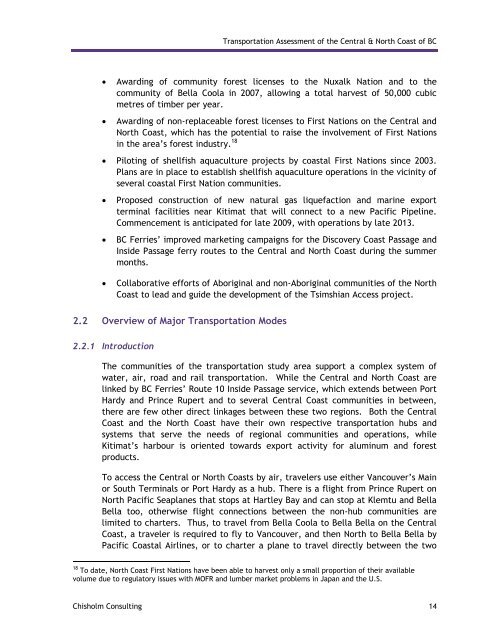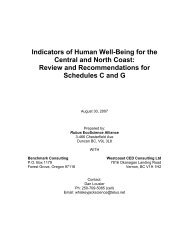Final report - Integrated Land Management Bureau
Final report - Integrated Land Management Bureau
Final report - Integrated Land Management Bureau
You also want an ePaper? Increase the reach of your titles
YUMPU automatically turns print PDFs into web optimized ePapers that Google loves.
Transportation Assessment of the Central & North Coast of BC<br />
• Awarding of community forest licenses to the Nuxalk Nation and to the<br />
community of Bella Coola in 2007, allowing a total harvest of 50,000 cubic<br />
metres of timber per year.<br />
• Awarding of non-replaceable forest licenses to First Nations on the Central and<br />
North Coast, which has the potential to raise the involvement of First Nations<br />
in the area’s forest industry. 18<br />
• Piloting of shellfish aquaculture projects by coastal First Nations since 2003.<br />
Plans are in place to establish shellfish aquaculture operations in the vicinity of<br />
several coastal First Nation communities.<br />
• Proposed construction of new natural gas liquefaction and marine export<br />
terminal facilities near Kitimat that will connect to a new Pacific Pipeline.<br />
Commencement is anticipated for late 2009, with operations by late 2013.<br />
• BC Ferries’ improved marketing campaigns for the Discovery Coast Passage and<br />
Inside Passage ferry routes to the Central and North Coast during the summer<br />
months.<br />
• Collaborative efforts of Aboriginal and non-Aboriginal communities of the North<br />
Coast to lead and guide the development of the Tsimshian Access project.<br />
2.2 Overview of Major Transportation Modes<br />
2.2.1 Introduction<br />
The communities of the transportation study area support a complex system of<br />
water, air, road and rail transportation. While the Central and North Coast are<br />
linked by BC Ferries’ Route 10 Inside Passage service, which extends between Port<br />
Hardy and Prince Rupert and to several Central Coast communities in between,<br />
there are few other direct linkages between these two regions. Both the Central<br />
Coast and the North Coast have their own respective transportation hubs and<br />
systems that serve the needs of regional communities and operations, while<br />
Kitimat’s harbour is oriented towards export activity for aluminum and forest<br />
products.<br />
To access the Central or North Coasts by air, travelers use either Vancouver’s Main<br />
or South Terminals or Port Hardy as a hub. There is a flight from Prince Rupert on<br />
North Pacific Seaplanes that stops at Hartley Bay and can stop at Klemtu and Bella<br />
Bella too, otherwise flight connections between the non-hub communities are<br />
limited to charters. Thus, to travel from Bella Coola to Bella Bella on the Central<br />
Coast, a traveler is required to fly to Vancouver, and then North to Bella Bella by<br />
Pacific Coastal Airlines, or to charter a plane to travel directly between the two<br />
18 To date, North Coast First Nations have been able to harvest only a small proportion of their available<br />
volume due to regulatory issues with MOFR and lumber market problems in Japan and the U.S.<br />
Chisholm Consulting 14

















